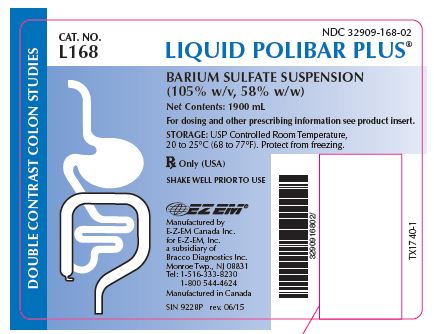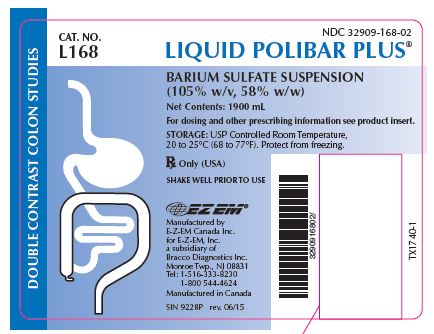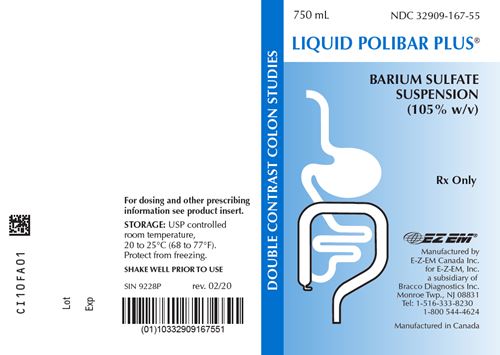Label: LIQUID POLIBAR PLUS- barium sulfate suspension
- NDC Code(s): 32909-167-55, 32909-168-02
- Packager: E-Z-EM Canada Inc
- Category: HUMAN PRESCRIPTION DRUG LABEL
- DEA Schedule: None
- Marketing Status: unapproved drug other
DISCLAIMER: This drug has not been found by FDA to be safe and effective, and this labeling has not been approved by FDA. For further information about unapproved drugs, click here.
Drug Label Information
Updated February 1, 2021
If you are a consumer or patient please visit this version.
- Download DRUG LABEL INFO: PDF XML
- Official Label (Printer Friendly)
-
DESCRIPTION
LIQUID POLIBAR PLUS® Barium Sulfate Suspension (105% w/v, 58% w/w) is a barium sulfate suspension for oral and rectal administration. Each 100 mL contains 105 g barium sulfate. Barium sulfate, due to its high molecular density is opaque to x-rays and, therefore, acts as a positive contrast agent for radiographic studies. The active ingredient is barium sulfate and its structural formula is BaSO4. Barium sulfate occurs as a fine, white, odorless, tasteless, bulky powder which is free from grittiness. Its aqueous suspensions are neutral to litmus. It is practically insoluble in water, solutions of acids and alkalies, and organic solvents.
- CLINICAL PHARMACOLOGY
- INDICATIONS AND USAGE
- CONTRAINDICATIONS
-
WARNINGS
Rarely, severe allergic reactions of an anaphylactoid nature, have been reported following administration of barium sulfate contrast agents. Appropriately trained personnel and facilities should be available for emergency treatment of severe reactions and should remain available for at least 30 to 60 minutes following administration, since delayed reactions can occur.
-
PRECAUTIONS
General
Diagnostic procedures which involve the use of radiopaque contrast agents should be carried out under the direction of personnel with the requisite training and with a thorough knowledge of the particular procedure to be performed. A history of bronchial asthma, atopy, as evidenced by hay fever and eczema, or a previous reaction to a contrast agent, warrant special attention. Caution should be exercised with the use of radiopaque media in severely debilitated patients and in those with marked hypertension or advanced cardiac disease.
Ingestion of this product is not recommended in patients with a history of food aspiration. If barium studies are required in these patients or in patients in whom integrity of the swallowing mechanism is unknown, proceed with caution. If this product is aspirated into the larynx, further administration should be immediately discontinued.
After any barium study of the GI tract, it is important to rehydrate the patient as quickly as possible to prevent impaction of the bowel by barium sulfate. To prevent barium sulfate impaction in the bowel, the use of mild laxatives such as milk of magnesia or lactulose, following completion of the examination may also be required. These mild laxatives are recommended on a routine basis and in patients with a history of constipation unless contraindicated.
Oral Administration
Use with caution in patient with complete or nearly complete obstruction of the gastrointestinal tract.
Rectal Administration
Use with caution when obstructive lesions of the colon are suspected. Care should be taken to minimize the amount of barium sulfate allowed to flow proximal to obstructive lesions of the colon. When used rectally, care must be taken during insertion of the enema tip into the patient, since forceful or too deep insertion may cause tearing or perforation of the rectum.
Information for Patients
Before administration of this product patients should be instructed to:
- Inform their physician if they are pregnant.
- Inform their physician if they are allergic to any drugs or food, or if they have had any prior reactions to barium sulfate products or other contrast agents used in x-ray procedures (see PRECAUTIONS - General).
- Inform their physician about any other medications they are currently taking.
Drug Interactions
The presence of barium sulfate formulations in the GI tract may alter the absorption of therapeutic agents taken concomitantly. In order to minimize any potential change in absorption, the separate administration of barium sulfate from that of other agents should be considered.
-
ADVERSE REACTIONS
Adverse reactions, such as nausea, vomiting, diarrhea and abdominal cramping, accompanying the use of barium sulfate formulations are infrequent and usually mild. Severe reactions (approximately 1 in 1,000,000) and fatalities (approximately 1 in 10,000,000) have occurred. Procedural complications are rare, but may include aspiration pneumonitis, barium sulfate impaction, granuloma formation, intravasation, embolization and peritonitis following intestinal perforation, vasovagal and syncopal episodes, and fatalities. EKG changes have been reported following or during barium enema procedures. It is of the utmost importance to be completely prepared to treat any such occurrence.
-
ALLERGIC REACTIONS
Due to the increased likelihood of allergic reactions in atopic patients, it is important that a complete history of known and suspected allergies as well as allergic-like symptoms, e.g., rhinitis, bronchial asthma, eczema and urticaria, must be obtained prior to any medical procedure utilizing these products. A mild allergic reaction would most likely include generalized pruritus, erythema or urticaria (approximately 1 in 250,000). Such reactions will generally respond to an antihistamine such as 50 mg of diphenhydramine or its equivalent. In the rarer, more serious reactions (approximately 1 in 1,000,000) laryngeal edema, bronchospasm or hypotension could develop. Severe reactions which may require emergency measures are often characterized by peripheral vasodilation, hypotension, reflex tachycardia, dyspnea, agitation, confusion and cyanosis progressing to unconsciousness. Treatment should be initiated immediately with 0.3 to 0.5 mL of 1:1000 epinephrine subcutaneously. If bronchospasm predominates, 0.25 to 0.50 grams of intravenous aminophylline should be given slowly. Appropriate vasopressors might be required. Adrenocorticosteroids, even if given intravenously, exert no significant effect on the acute allergic reactions for a few hours. The administration of these agents should not be regarded as emergency measures for the treatment of allergic reactions.
Apprehensive patients may develop weakness, pallor, tinnitus, diaphoresis and bradycardia following the administration of any diagnostic agent. Such reactions are usually non-allergic in nature and are best treated by having the patient lie flat for an additional 10 to 30 minutes under observation.
All E-Z-EM barium contrast and barium contrast delivery systems are latex-free. However, allergic reactions to enema accessories, in particular to retention catheters (tips) with latex cuffs, can occur. Such reactions could occur immediately and result in the previously mentioned acute allergic-like responses or might be delayed in appearance and result in a contact dermatitis. Known atopic patients, particularly those with a history of asthma or eczema, should be evaluated for alternative methods of administration in order to avoid these adverse reactions. All plastic/rubber accessories are disposable, single-use devices that must not be reused or left in the body cavity for an extended period of time.
- OVERDOSAGE
-
DOSAGE AND ADMINISTRATION
General
The volume and concentration of LIQUID POLIBAR PLUS® to be administered will depend on the degree and extent of contrast required in the area(s) under examination and on the equipment and technique employed. See applicable system below for typical adult dose.
Patient Preparation for Colon Examinations
In order to achieve optimum results, the colon must be cleansed prior to the use of a barium enema. This is usually accomplished by placing the patient on a low fat, low residue diet, combined with the use of laxatives and/or cathartics. A cleansing enema may also be used unless contraindicated.
-
RECTAL ADMINISTRATION
In order to assure rapid colonic filling and drainage, LIQUID POLIBAR PLUS® should only be used with an enema kit with a large (½ inch) lumen such as the Super XL® Enema Bag System (Cat. No. 8925) or equivalent. Refer to the enema kit labeling for additional CONTRAINDICATIONS, WARNINGS, PRECAUTIONS, and INSTRUCTIONS FOR USE. Refer to manufacturer’s instructions if another administration system is used.
-
ORAL ADMINISTRATION
Esophagus and Cardiac Series
Undiluted LIQUID POLIBAR PLUS® should be administered orally for double-contrast examination of the esophagus. Films are taken during rapid swallowing of barium sulfate.
Typical Adult Dose: 60 mL to 300 mLStomach
LIQUID POLIBAR PLUS® can be used for single or double-contrast examination of the stomach. It can be used undiluted or diluted 1:1 with water to produce a 52.5% w/v. Diluted LIQUID POLIBAR PLUS® is highly suited for a biphasic examination of the stomach. Following completion of the double-contrast examination of the stomach using E-Z-HD™ barium sulfate, undiluted or diluted 1:1 with water, LIQUID POLIBAR PLUS® may be used for the single phase of the study.
Typical Adult Dose: 150 mL to 340 mL of diluted or undiluted as applicable.Small Bowel Series
LIQUID POLIBAR PLUS® can be used for small bowel series. It can be given alone or can be used following the completion of a double-contrast examination of the stomach using E-Z-HD™. It may be given either undiluted or in 1:1 dilution. Higher dilution will decrease the density of the barium sulfate but will increase the speed of the flow of contrast.
Typical Adult Dose: 340 mL to 750 mL of diluted or undiluted as applicable. - STORAGE
- HOW SUPPLIED
- SPL UNCLASSIFIED SECTION
- PRINCIPAL DISPLAY PANEL
-
INGREDIENTS AND APPEARANCE
LIQUID POLIBAR PLUS
barium sulfate suspensionProduct Information Product Type HUMAN PRESCRIPTION DRUG Item Code (Source) NDC:32909-168 Route of Administration ORAL, RECTAL Active Ingredient/Active Moiety Ingredient Name Basis of Strength Strength barium sulfate (UNII: 25BB7EKE2E) (barium sulfate - UNII:25BB7EKE2E) barium sulfate 1.05 g in 1 mL Inactive Ingredients Ingredient Name Strength acacia (UNII: 5C5403N26O) anhydrous citric acid (UNII: XF417D3PSL) dimethicone 350 (UNII: 2Y53S6ATLU) dimethicone 1000 (UNII: MCU2324216) hydrochloric acid (UNII: QTT17582CB) polysorbate 80 (UNII: 6OZP39ZG8H) potassium chloride (UNII: 660YQ98I10) potassium sorbate (UNII: 1VPU26JZZ4) water (UNII: 059QF0KO0R) saccharin sodium (UNII: SB8ZUX40TY) silicon dioxide (UNII: ETJ7Z6XBU4) sodium benzoate (UNII: OJ245FE5EU) carrageenan (UNII: 5C69YCD2YJ) trisodium citrate dihydrate (UNII: B22547B95K) sorbitol (UNII: 506T60A25R) xanthan gum (UNII: TTV12P4NEE) Product Characteristics Color WHITE Score Shape Size Flavor VANILLA Imprint Code Contains Packaging # Item Code Package Description Marketing Start Date Marketing End Date 1 NDC:32909-168-02 1900 mL in 1 JUG; Type 0: Not a Combination Product 08/01/1984 11/01/2021 Marketing Information Marketing Category Application Number or Monograph Citation Marketing Start Date Marketing End Date Unapproved drug other 08/01/1984 11/01/2021 LIQUID POLIBAR PLUS
barium sulfate suspensionProduct Information Product Type HUMAN PRESCRIPTION DRUG Item Code (Source) NDC:32909-167 Route of Administration ORAL, RECTAL Active Ingredient/Active Moiety Ingredient Name Basis of Strength Strength barium sulfate (UNII: 25BB7EKE2E) (barium sulfate - UNII:25BB7EKE2E) barium sulfate 1.05 g in 1 mL Inactive Ingredients Ingredient Name Strength acacia (UNII: 5C5403N26O) anhydrous citric acid (UNII: XF417D3PSL) dimethicone 350 (UNII: 2Y53S6ATLU) dimethicone 1000 (UNII: MCU2324216) hydrochloric acid (UNII: QTT17582CB) polysorbate 80 (UNII: 6OZP39ZG8H) potassium chloride (UNII: 660YQ98I10) potassium sorbate (UNII: 1VPU26JZZ4) water (UNII: 059QF0KO0R) saccharin sodium (UNII: SB8ZUX40TY) silicon dioxide (UNII: ETJ7Z6XBU4) sodium benzoate (UNII: OJ245FE5EU) carrageenan (UNII: 5C69YCD2YJ) trisodium citrate dihydrate (UNII: B22547B95K) sorbitol (UNII: 506T60A25R) xanthan gum (UNII: TTV12P4NEE) Product Characteristics Color WHITE Score Shape Size Flavor VANILLA Imprint Code Contains Packaging # Item Code Package Description Marketing Start Date Marketing End Date 1 NDC:32909-167-55 750 mL in 1 BOTTLE, PLASTIC; Type 0: Not a Combination Product 02/01/2021 Marketing Information Marketing Category Application Number or Monograph Citation Marketing Start Date Marketing End Date Unapproved drug other 02/01/2021 Labeler - E-Z-EM Canada Inc (204211163) Registrant - E-Z-EM, INC. (002041226) Establishment Name Address ID/FEI Business Operations E-Z-EM Canada Inc 204211163 ANALYSIS(32909-168, 32909-167) , MANUFACTURE(32909-168, 32909-167) , PACK(32909-168, 32909-167) , LABEL(32909-168, 32909-167)




